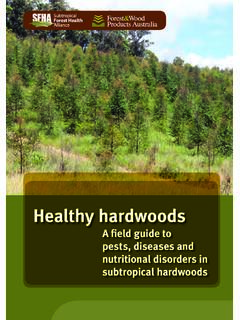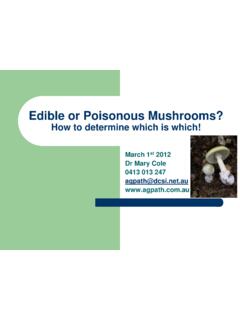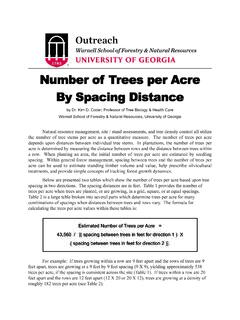Transcription of ECOLOGICAL RESTORATION: AN OVERVIEW
1 ECOLOGICAL restoration : AN OVERVIEW . AAN N. A FAQ document intended to give a broad OVERVIEW of the concept and practice of ECOLOGICAL restoration to the reader. Humankind has not woven the web of life. We are but one thread within it. Whatever we do to the web, we do to ourselves. All things are bound together. All things connect . - Chief Seattle ECOLOGICAL restoration : AN OVERVIEW . 1. What is ECOLOGICAL restoration ? ECOLOGICAL restoration is the exercise aimed at restoring an ecosystem that has been disturbed, degraded or impaired to as close its original state as possible. In most restoration situations, such disturbance or degradation is a direct or indirect result of human activities. In rare instances restoration of critical sites may be taken up after natural disasters like major floods or fires.
2 2. How is ECOLOGICAL restoration different from afforestation and reforestation? The terms afforestation, reforestation and restoration are often used interchangeably. However these mean different things. Afforestation is the process of establishing vegetation in an area that was not a forest earlier. Species selection focus is often mono-cultural or a few fast growing species as in plantations, with a view to harvesting them. Reforestation is growing vegetation back on what was previously a forest area, but has lost all or most of its original vegetation due to various reasons. It also generally involves the activity of planting saplings but diversity of introduced species could be greater than in afforestation.
3 Species integrity is generally not a priority in reforestation and exotic species Eucalyptus may also be introduced. An example is Europe where many natural forests have been reforested over the last two centuries using species that are useful for humans. Afforestation and reforestation, therefore, often do not create forests that represent biodiversity. ECOLOGICAL restoration , on the other hand, is about assisting, and/or accelerating, the revival of impaired ECOLOGICAL processes that are vital for an ecosystem to function normally and support the biodiversity typical of that ecosystem. The focus is on multiple aspects like soil alleviation, hydrology, filling species gaps, etc. Ecosystem integrity and species integrity are high priorities in ECOLOGICAL restoration (see question 7 below on principles governing restoration activity).
4 3. Does ECOLOGICAL restoration apply only to forest ecosystems? This can be answered in two parts. Firstly, contrary to the terms afforestation and reforestation that are used with reference to terrestrial forests with tree cover, ECOLOGICAL restoration includes a wide variety of ecosystems that may or may not have tree cover terrestrial, marine, fresh water, wetland, coastal, desert, etc. Secondly, ECOLOGICAL restoration is not necessarily limited to forest areas and could include areas outside designated forest areas abandoned mining or industrial sites, urban ecosystems including lakes, rivers and beaches, rural areas like village sacred groves, etc. It could even be carried out in privately owned lands estates being restored to original forests.
5 4. Can ECOLOGICAL restoration restore an eco-system to its original state? Ecosystems are in a constant process of evolution and it is impossible to restore one to its original state. The objective of ECOLOGICAL restoration , therefore, is to put an ecosystem back on its original trajectory which existed before the disturbance or impairment took place. 5. Is restoration essential? Will not ecosystems restore themselves if left alone? Whether restoration is required or not depends on the degree of impairment of ECOLOGICAL processes that the ecosystem has suffered. A good analogy is the human body. Where the immune system of a person is reasonably intact, he or she can recover from a health setback.
6 However where the immune system is severely compromised, medical intervention is needed. Similarly, where an ecosystem is mildly impaired, it may be able to recover on its own with merely the cessation of causes of the impairment. However where the degree of impairment or degradation is high, intervention in the form of restoration would be needed in a majority of cases. 6. What are the risks of not restoring an ecosystem that is moderately or severely impaired? Not restoring such an ecosystem could have three ECOLOGICAL consequences. Firstly, the ecosystem might not be able to restore by itself and therefore remains in a degraded state. A good example is an urban marshland that has been used as a garbage dumping ground, as in the case of Pallikaranai Marsh near Chennai.
7 Second, assuming the ecosystem can recover on its own, this process might take a very long time. This is the case with abandoned mines or areas affected by invasive weeds. The capability of such an ecosystem to deliver ecosystem services may hence be deferred interminably. Thirdly, the ecosystem might recover on its own in a manner that does not reflect its earlier state. For example, degraded/disturbed areas generally witness high incidence of exotic and invasive plant species/weeds. Therefore the character of the ecosystem might undergo a change. 7. What are the key principles of ECOLOGICAL restoration ? There are three key principles of restoration . The first is maintaining ecosystem integrity.
8 One should not try to create an ecosystem that is different from the original ecosystem type. For instance, one should not try and create a grassland in place of a dry deciduous forest or vice versa. The second is species integrity. This is about ensuring that only the right types of species that are indigenous or native to the target ecosystem are introduced in the restoration process. The third is the principle of least possible intervention. This involves using passive restoration techniques as far as possible and using active methods only where passive methods are not feasible. The focus should be on reviving the ECOLOGICAL processes and bringing the ecosystem to a self-sustaining level where the rest of the restoration process can be taken over by nature.
9 8. What do we mean by passive restoration methods? Passive restoration involves the use of low-intensity techniques that aim at leveraging natural ECOLOGICAL processes for achieving the restoration goals. Let us take the case of a terrestrial forest. The focus of passive restoration is on reviving the soil, water and natural vegetation cycles. Introduction of outside plant or seed material is kept to a minimum to address species gaps. A. typical restoration activity would be rain water harvesting in places that have high water run-off due to degradation or soil compacting. The increased moisture level enables natural establishment of grass species. Grass helps alleviate the soil and also in attracting seed dispersal agents like birds and herbivores.
10 Grass is a good successional species that nurtures other plant species by protecting seeds, providing moisture, etc. When new plants get established they in turn improve the water and soil cycles. Passive restoration , by creating a virtuous cycle where various ECOLOGICAL parameters support each other in a symbiotic manner, is able to create a framework that accelerates restoration . While the example given above is that of a terrestrial forest, similar relationships can be found in all ecosystems. 9. What are active restoration methods and when are these used? Active restoration involves the use of moderate to high intervention techniques a terrestrial forest this could include sapling planting, seed broadcasting, invasive species management, etc.







